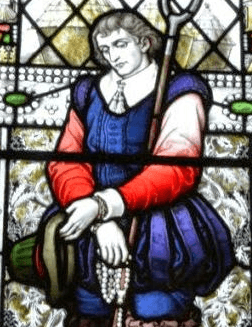John Finch (martyr) facts for kids
Quick facts for kids BlessedJohn Finch |
|
|---|---|

A stained glass window in St. Mary's Catholic Church in Chorley, England
|
|
| Martyr | |
| Born | c. 1548 Eccleston, Lancashire |
| Died | 20 April 1584 (aged 35 - 36) Lancaster, England |
| Venerated in | Roman Catholic Church |
| Beatified | 15 December 1929, Rome by Pope Pius XI |
| Feast | 20 April and 4 May (Holy English Martyrs) |
| Attributes | hat, rosary, pitchfork |
John Finch (born around 1548, died April 20, 1584) was an English farmer. He was a Roman Catholic who faced challenges for his faith. The Catholic Church honors him as a martyr, and he was declared 'Blessed' in 1929.
John Finch's Early Life
John Finch was born in Eccleston, Lancashire, around 1548. His family was Catholic, but he was raised as an Anglican. An Anglican is a member of the Church of England.
When he was about 20, John moved to London. He stayed with cousins at a place called Inner Temple. In London, he saw differences between Protestant and Catholic ways of life. This made him decide to live as a Catholic.
Returning Home
John could not find a good job in London. So, he went back to Lancashire. There, he officially rejoined the Catholic Church. He got married and started a family.
His home became a secret meeting place for Catholic priests. He helped them and taught others about the Catholic faith. John's main job was to safely guide priests between Catholic homes.
Facing Challenges
John's actions made the authorities upset. At Christmas in 1581, he was tricked into bringing a priest, George Ostliffe, to a certain place. Both John and the priest were then arrested.
People were told that John had betrayed the priest and other Catholics. They said he had gone to live with the Earl of Derby. But this was not true. John was actually kept as a prisoner in the Earl's house.
He was sometimes hurt or offered money to give information. John was later moved to the New Fleet Prison in Manchester. After that, he was sent to the House of Correction.
When he refused to go to the Protestant church, he was dragged there. His head hit the stones as he was pulled.
Trial and Execution
After three years in prison, John was sent to Lancaster for trial. He was tried with three priests on April 18, 1584.
He was found guilty. On April 20, he was executed in Lancaster with James Bell.

